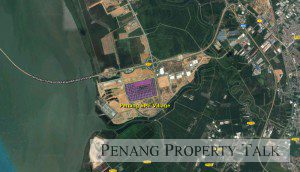Penang’s SME Village ready by 2019
 The Penang Development Corporation (PDC) targets to complete the development of the 60ha (150 acres) SME Village in Batu Kawan by 2019.
The Penang Development Corporation (PDC) targets to complete the development of the 60ha (150 acres) SME Village in Batu Kawan by 2019.
Special Advisor to Penang Chief Minister and investPenang director Datuk Seri Lee Kah Choon told StarBiz that to-date PDC had sold all the one to two-acre bungalow lots in the first phase of the SME Village, and almost all the landed properties in the second phase.
The bungalow lots in the first phase were sold for around RM40 per sq ft and are suitable for building detached factories.
“For the second phase, comprising 40 terraced and four semi-detached light industrial units, we have sold 40 units of the properties, priced from RM800,000 onwards.
“They should be ready for the owners to move in by the end of 2016,” he said.
Lee said the third phase, comprising a service centre, would be ready by next year.
“We will look at the demand for industrial properties next year, so that we can plan for light industrial properties most suitable for the fourth and fifth phases of the SME Village.
“The automation cluster could be on the fifth phase,” Lee added.
On future investments into Penang, according to Lee, there are three big medical device companies from US and Europe interested to set up manufacturing operations in Penang.
“Negotiations are underway. We expect to see some results next year,” Lee added.
It was recently reported by StarBiz that Minnesota-based Lake Region Medical Inc, a maker of medical devices and consumer healthcare manufacturer Johnson & Johnson are in talks with Seagate Technology to acquire the latter’s 16.4ha land in Batu Kawan.
Talks between the companies, however, are still at the preliminary stage.
Seagate, which acquired the land two years ago, is closing down its hard disk manufacturing operations in Penang by mid next year.
According to the data from Medical Manufacturing Asia 2016, the medical device market in the Asean region is projected to double from US$4.6bil in 2013 to US$9bil in 2019.
“Three Asean countries – Malaysia, Indonesia, and Thailand – account for approximately 65% of the current medical device market among the 10 member countries,” the Medical Manufacturing Asia 2016 report says.
Affordable medical devices, cardiac devices in particular, are in demand in Asia.
Lee said the merger and acquisition exercises undertaken by some of the global multi-national corporations (MNCs) could result in the movement of higher-end technologies and new products being move to another cost effective location.
“When companies merge, there would be consolidation exercises, which could prompt the migration of technologies or new products to other cost effective manufacturing sites.
“This is why it is important for the country and Penang to be competitive in the cost of doing business, have a ready pool of talents, and the necessary infrastructure to attract these new investments,” Lee said.
Meanwhile, The Free Industrial Zone, Penang, Companies’ Association’s (Frepenca) is forecasting that the fourth quarter 2016 would improve over the preceding third period.
“Some 74% of the members are projecting their performance to improve in the final quarter of 2016 over the previous third quarter.
“About 16% are forecasting a flat fourth quarter, and the remaining 10% a drop in their revenue,” Frepenca committee member Datuk Heng Huck Lee said.
For the third quarter 2016, some 54% are expecting an improvement in their revenue over the second quarter.
“About 42% are seeing a flat third period, while the remaining 5% a drop in their revenue,” Heng said.
The Frepenca companies, comprising 75 local firms and multinational corporations from the United States and Europe, are involved in the semiconductor and electronics industries.
Source: TheStar.com.my

